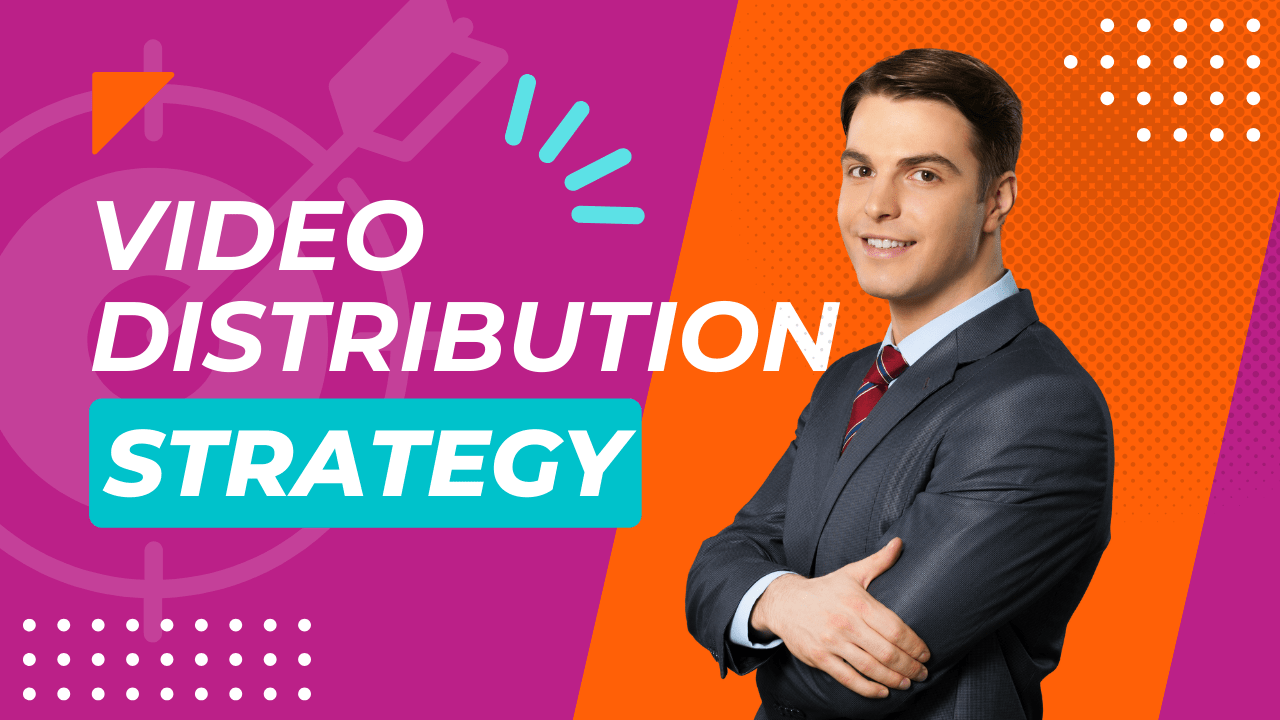In today’s digital landscape, videos have become a dominant medium for communication, marketing, and entertainment. With the rise of video-sharing platforms and the increasing consumption of video content, it’s more important than ever for creators and businesses to have a well-defined video distribution strategy. This guide will provide an in-depth look at how to effectively distribute your video content, ensuring maximum reach, engagement, and impact. We’ll cover everything from choosing the right platforms and optimizing your content to engaging with your audience and analyzing your video’s performance.
What is a Video Distribution Strategy?
A video distribution strategy is a comprehensive plan that outlines how and where to share your video content to reach your target audience. It involves selecting the appropriate platforms, timing the release, optimizing the video content for each platform, and interacting with the audience. The ultimate goal is to ensure that your videos are seen by the right people and achieve the desired outcomes, such as increased brand awareness, higher engagement, or more conversions.
A successful video distribution strategy takes into account various factors, including the type of content, the target audience, the platforms used, and the specific goals of the campaign. It is a dynamic process that requires continuous monitoring and adjustment to stay relevant and effective in a rapidly changing digital landscape.
Importance of a Video Distribution Strategy
Creating high-quality video content is only half the battle; getting that content in front of the right audience is equally important. A well-executed video distribution strategy can help you achieve several key objectives:
- Maximizing Reach: A strategic approach ensures that your videos reach a wide and diverse audience. By leveraging multiple platforms and channels, you can extend your content’s visibility and attract viewers who might not have encountered it otherwise.
- Targeting the Right Audience: Not all viewers are the same. A targeted video distribution strategy allows you to reach the specific demographics that are most likely to engage with your content. This can lead to higher engagement rates and more meaningful interactions.
- Optimizing for Platforms: Different platforms have different formats, audiences, and algorithms. A good strategy tailors the content to suit each platform, optimizing factors like video length, format, and metadata to improve performance.
- Enhancing Engagement: A strategic distribution plan includes engaging with viewers through comments, shares, and other interactions. This not only fosters a sense of community but also encourages viewers to take desired actions, such as subscribing, sharing, or purchasing a product.
- Measuring Success: A well-defined strategy provides a framework for measuring success. By tracking key performance indicators (KPIs), you can assess the effectiveness of your videos and make informed decisions about future content and distribution methods.
Key Components of a Video Distribution Strategy
To create an effective video distribution strategy, you need to consider several key components:
1. Identify Your Goals
Before diving into distribution, it’s crucial to define your goals. Are you looking to increase brand awareness, drive traffic to your website, generate leads, or promote a specific product? Your goals will shape your entire strategy, from the type of content you create to the platforms you choose for distribution. Clear, measurable goals will also help you evaluate the success of your campaigns.
2. Know Your Audience
Understanding your target audience is fundamental to any successful marketing strategy, and video distribution is no exception. Conduct thorough research to identify the demographics, interests, and behaviors of your audience. Use analytics tools and data from previous campaigns to gather insights. Knowing your audience helps you create content that resonates with them and choose the right platforms for distribution.
3. Choose the Right Platforms
The choice of platforms is a critical aspect of a video distribution strategy. Each platform has its unique audience, content format, and algorithm. Here are some popular platforms to consider:
- YouTube: As the largest video-sharing platform, YouTube is ideal for reaching a broad audience. It supports various content types, from tutorials and vlogs to music videos and product reviews.
- Instagram: Known for its visually appealing content, Instagram is perfect for short, engaging videos, especially through features like Stories, IGTV, and Reels. It’s popular among younger audiences and is excellent for lifestyle, fashion, and entertainment content.
- Facebook: With a diverse user base, Facebook is a versatile platform for sharing videos. It supports a wide range of video lengths and formats, making it suitable for both short clips and longer, more detailed content.
- Vimeo: Vimeo is a platform for high-quality, professional videos. It’s a great choice for filmmakers, artists, and brands that prioritize quality over quantity.
- LinkedIn: Ideal for B2B content, LinkedIn is a professional network where you can share industry-related videos, webinars, and company updates.
4. Optimize Your Videos
Optimization is crucial to ensure your videos perform well on each platform. This includes optimizing the video title, description, tags, and thumbnail. Use relevant keywords to improve discoverability and make sure the video is the right length for the platform. For instance, while YouTube and Vimeo can accommodate longer videos, platforms like Instagram and TikTok are better suited for shorter content.
Other optimization strategies include:
- Custom Thumbnails: Create eye-catching thumbnails that accurately represent the content. A compelling thumbnail can significantly increase click-through rates.
- Captions and Subtitles: Adding captions or subtitles can make your videos more accessible and improve engagement, especially for viewers watching without sound.
- Calls to Action (CTAs): Include clear CTAs to guide viewers on what to do next, whether it’s visiting your website, subscribing to your channel, or making a purchase.
5. Create a Distribution Schedule
Timing is a crucial factor in a video distribution strategy. Analyze when your target audience is most active on different platforms and schedule your video releases accordingly. Consistent posting at optimal times can boost visibility and engagement. Use analytics tools to track performance and refine your schedule over time.
6. Engage with Your Audience
Engagement is key to building a loyal following. Respond to comments, answer questions, and encourage viewers to share your videos. Interaction fosters a sense of community and can lead to increased loyalty and advocacy. Additionally, engaging with your audience can provide valuable feedback and insights into their preferences and expectations.
7. Analyze and Adjust
A successful video distribution strategy requires continuous monitoring and analysis. Use analytics tools to track metrics like views, watch time, engagement, and conversion rates. Analyze the data to understand what works and what doesn’t. Based on these insights, adjust your strategy to improve future campaigns. For example, if you notice higher engagement on Instagram Stories than on IGTV, you might prioritize Stories in your content calendar.
Best Practices for Video Distribution
To make the most of your video distribution strategy, follow these best practices:
1. Create High-Quality Content
Quality should always be a top priority. High-quality videos are more likely to be shared, engaged with, and remembered. Invest in good equipment, use professional editing software, and pay attention to details like lighting and sound. A well-produced video not only attracts viewers but also enhances your brand’s image.
2. Use Eye-Catching Thumbnails
Thumbnails are often the first thing viewers see when browsing videos. An eye-catching thumbnail can significantly increase the chances of someone clicking on your video. Ensure your thumbnails are relevant to the content, visually appealing, and properly sized for each platform. Avoid clickbait thumbnails that misrepresent the content, as they can lead to viewer disappointment and lower retention rates.
Social media platforms are powerful tools for video distribution. Share your videos across all your social media channels and encourage your followers to share them as well. Use hashtags and tags to increase visibility and join relevant conversations. Engage with your followers by responding to comments and messages, and consider running social media ads to reach a larger audience.
4. Collaborate with Influencers
Influencer collaborations can help you reach new audiences and add credibility to your content. Find influencers who align with your brand and have a following that matches your target audience. Collaborations can take various forms, such as sponsored content, guest appearances, or co-created videos. An influencer’s endorsement can significantly boost your video’s reach and engagement.
5. Use Paid Promotions
While organic reach is valuable, paid promotions can give your video distribution strategy a significant boost. Use paid ads on platforms like YouTube, Facebook, Instagram, and TikTok to reach a larger audience. Paid promotions can be targeted based on demographics, interests, and behaviors, ensuring your videos are seen by the right people.
6. Repurpose Content
Repurposing content is a cost-effective way to extend the life of your videos. For example, you can turn video clips into GIFs, infographics, or blog posts. This approach not only saves time and resources but also helps you reach different segments of your audience. For instance, a detailed tutorial video can be broken down into shorter clips for social media or transformed into a step-by-step blog post.
Common Mistakes to Avoid in Video Distribution
Even the best plans can falter if certain pitfalls aren’t avoided. Here are some common mistakes that can undermine your video distribution strategy:
- Ignoring the Audience: Failing to understand your audience can result in low engagement. Always research your audience’s preferences and tailor your content accordingly.
- Not Optimizing for Mobile: With the increasing consumption of videos on mobile devices, it’s crucial to optimize your videos for mobile viewing. Ensure that your videos are compatible with mobile formats and that the content is easily digestible on smaller screens.
- Overlooking SEO: Video SEO is essential for increasing discoverability. Use relevant keywords in your video title, description, and tags. Optimizing your video content for search engines can help it rank higher in search results, leading to more views.
- Inconsistent Posting: Inconsistent posting can lead to a loss of audience interest. Develop a content calendar and stick to a regular posting schedule to keep your audience engaged and coming back for more.
- Neglecting Analytics: Without analyzing your video’s performance, you can’t improve your strategy. Regularly review analytics to understand what’s working and what’s not. Use the insights to refine your approach and achieve better results in future campaigns.
Conclusion
In conclusion, a well-crafted video distribution strategy is essential for maximizing the reach and impact of your video content. By understanding your audience, choosing the right platforms, optimizing your videos, and engaging with your audience, you can ensure that your videos achieve their desired goals. Remember to continuously analyze and adjust your strategy based on performance data to stay relevant and effective in a dynamic digital landscape. With the right strategy, you can turn your video content into a powerful tool for communication, marketing, and engagement. Whether you’re a brand, a content creator, or an individual looking to share your message, a strategic approach to video distribution can help you reach new heights.
By implementing these strategies and best practices, you can create a comprehensive video distribution plan that maximizes your content’s potential and achieves your desired outcomes. Whether you’re aiming to increase brand awareness, drive traffic, or generate leads, a well-executed video distribution strategy is your key to success in the digital age.
For further reading, explore these related articles:
- How to Distribute Your Music Video: A Comprehensive Guide
- The Ultimate Guide to iTunes Video Distribution: How to Get Your Music Videos to the World
- The Ultimate Guide on How to Distribute Video Content Effectively
For additional resources on music marketing and distribution, visit Deliver My Tune.






